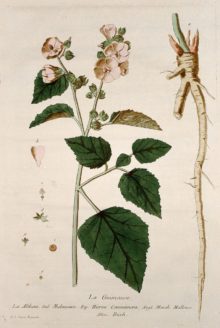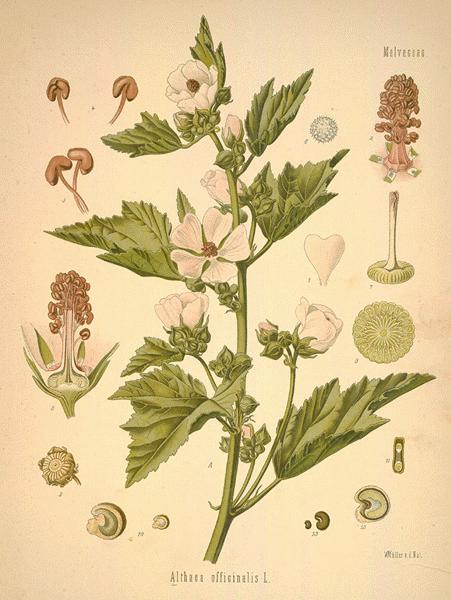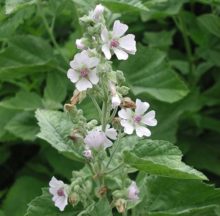Marsh Mallow
- Scientific Name: Althaea officinalis
- Plant Family: Malvaceae
- Parts Used: The whole plant – Leaves, root, flowers.
- Actions (root): Demulcent, Diuretic, Emollient, Vulnerary
- Actions (leaf): Demulcent, Expectorant, Diuretic, Emollient, Anti-Catarrhal, Pectoral
The Basics:
All mallows, including the garden hollyhock, contain quantities of mucilage and the marsh mallow is an especially soothing, healing herb, useful in treating bronchitis, internal inflammation and irritation, for stimulating the kidneys and as a gentle laxative. Tea made from the leaves makes a soothing eye bath.
The high mucilage content of Marsh Mallow makes it an excellent demulcent (relieves inflammation). The root is used primarily for digestive problems, inflammations of the digestive tract and on the skin. The leaf is used for the lungs and the urinary system. For bronchitis, respiratory catarrh and irritating coughs consider Marsh Mallow leaf. It is very soothing in urethritis and urinary gravel. Externally, the root is indicated in varicose veins and ulcers as well as abscesses and boils.
There are many species of mallow growing around the world, often used as food or medicine and possessing similar properties. The young leaves of all the European mallows can be eaten in salads, the older leaves in soups, the roots boiled or fried and the seeds, known as cheeses, chewed fresh. They are all wholesome and their flavor faint and delicate.
Habitat:
Marsh Mallow is a native of most countries of Europe, from Denmark southward. It grows in salt marshes, in damp meadows, by the sides of ditches, by the sea and on the banks of tidal rivers.
Collection:
The leaves should be collected in summer after flowering.They should be stripped off singly and gathered only on a fine day, in the morning, after the dew has been dried off by the sun. The root is unearthed in late fall. It is cleaned of root fibers and should be dried immediately.
Preparation and Dosage:
Decoction: Soak 4 oz of dried root over night in 6 1/2 pints of water. Boil until reduced by nearly half and strain. Take a spoonful three times a day. Inhale the steam for sinusitis
Infusion: Pour boiling water onto 1 to 2 teaspoonfuls of the dried leaf and let infuse for 10 minutes. This should be drunk three times a day. This also makes a soothing eye bath.
Compress: The fresh leaves, or crushed fresh root make an excellent hot poultice for inflammations, sprains, stings and aching muscles.
Tincture: Take 1 to 4 ml of the tincture three times a day.
Boiled: Boiled in wine or milk, Marsh Mallow will relieve diseases of the chest, constituting a popular remedy for coughs, bronchitis, whooping-cough, etc., generally in combination with other remedies. It is frequently given in the form of a syrup, which is best adapted to infants and children.
Other: The original Marsh Mallow sweets were sucked for sore throats and made by soaking a mixture of powdered root and sugar in water until it became a jelly.
Combinations:
In ulcerative conditions- internal or external – it may be used with Comfrey.
For bronchitis – use with Licorice and White Horehound.
It is often mixed with Slippery Elm to make ointments.
Historically:
 Most of the Mallows have been used as food, and are mentioned by early classic writers in this connection. Mallow was an esculent (edible) vegetable among the Romans, a dish of Marsh Mallow was one of their delicacies.
Most of the Mallows have been used as food, and are mentioned by early classic writers in this connection. Mallow was an esculent (edible) vegetable among the Romans, a dish of Marsh Mallow was one of their delicacies.
The Chinese use some sort of Mallow in their food, and Prosper Alpinus stated (in 1592) that a plant of the Mallow kind was eaten by the Egyptians. Many of the poorer inhabitants of Syria, especially the Fellahs, Greeks and Armenians, subsist for weeks on herbs, of which Marsh Mallow is one of the most common. When boiled first and fried with onions and butter, the roots are said to form a palatable dish, and in times of scarcity consequent upon the failure of the crops, this plant, which fortunately grows there in great abundance, is much collected for food.
In Job we read of Mallow being eaten in time of famine, but it is doubtful whether this was really a true mallow. Canon Tristram thinks it was some saline plant; perhaps the Orache, or Sea-Purslane.
The ancient Egyptians were known to have used it in a honey-sweetened confection for sore throat. Horace and Martial mention the laxative properties of the Marsh Mallow leaves and root, and Virgil tells us of the fondness of goats for the foliage of the Mallow.
Dioscorides extols it as a remedy, and in ancient days it was not only valued as a medicine, but was used, especially the Musk Mallow, to decorate the graves of friends.
Pliny said: ‘Whosoever shall take a spoonful of the Mallows shall that day be free from all diseases that may come to him.’ All Mallows contain abundant mucilage, and the Arab physicians in early times used the leaves as a poultice to suppress inflammation.
Folk Names:
- Cheeses – refers to the round, flattened fruits
- Gulkhairo
- Herba Malvae
- Mallards
- Malvavisco
- Mauls
- Mauve Blanche
- Mortification Root
- Racine de Guimauve
- Schloss Tea
- Sweet Weed
- White Mallow
- Wymote
Conventional Medicine:
Cough caused by ACE inhibitors. Medications used for high blood pressure called ACE inhibitors can sometimes cause coughing as a side effect. Early research suggests that taking marshmallow root by mouth for 4 weeks can reduce cough caused by ACE inhibitors. Some examples of ACE-inhibitors include captopril (Capoten), enalapril (Vasotec), and lisinopril (Prinivil, Zestril).
Skin infection caused by parasites (Leishmania lesions). Early research suggests that applying a combination of marshmallow and hollyhock extracts to affected skin for 5 days can help improve Leishmania lesions.
Cultivation:
Plant sections of fresh root, each carrying a bud, in light, damp soil, about 2 ft apart, or sow seed in the spring. Harvest and dry the leaves just before the flowers blossom. Dig the roots for drying in the fall.
The Other Mallows:
- Blue Mallow – Malva sylvestris
- Dwarf Mallow – Malva rotundifolia
- Hollyhock – Alcea
- Musk Mallow – Malva meschata
- Sea Tree Mallow – Lavatera arborea
Special Precautions & Warnings:
- Diabetes:
There is a concern that Marsh Mallow might interfere with blood sugar control. If you have diabetes, check your blood sugar carefully to avoid dangerously low blood sugar. - Surgery:
Marsh Mallow might affect blood sugar levels. There is a concern that it could interfere with blood sugar control during and after surgical procedures. Stop taking Marsh Mallow at least 2 weeks before a scheduled surgery.
Drug Interactions:
- Lithium:
Marsh Mallow might have an effect like a water pill or “diuretic.” Taking Marsh Mallow might decrease how well the body gets rid of lithium. This could increase how much lithium is in the body and result in serious side effects. Talk with your healthcare provider before using this product if you are taking lithium. Your lithium dose might need to be changed. - Medications for Diabetes:
Marsh Mallow might decrease blood sugar. Diabetes medications are also used to lower blood sugar. Taking Marsh Mallow along with diabetes medications might cause your blood sugar to go too low. Monitor your blood sugar closely. The dose of your diabetes medication might need to be changed. - Oral Medications:
Marsh Mallow contains a type of soft fiber called mucilage. Mucilage can decrease how much medicine the body absorbs. Taking Marsh Mallow at the same time you take medications by mouth can decrease the effectiveness of your medication. To prevent this interaction take Marsh Mallow at least one hour after medications you take by mouth.
Recipes and Formulas:
- Recipes and formulas that use Marsh Mallow can be found at: Folk Medicine Remedies and Cures
Note: This post was compiled from a variety of sources by shirleytwofeathers specifically for the Encyclopedia of Herbology. Do not copy or repost without credit and a link back to this website.
Rennie Luttrull: queen-annes-lace-seeds
Rosanna: Spignel aka Bald Money
Annamarie Squatrito: Fumitory
EILEEN Klinghagen: Pumpkin
Mahmudul Hasan: Celery




Leave a Reply